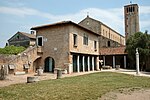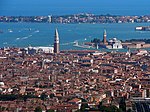Torcello Cathedral
11th-century Roman Catholic church buildings in Italy6397th-century churches in Italy864Basilica churches in Venice ... and 5 more
Byzantine church buildingsByzantine mosaicsChurches completed in 1008Commons category link is locally definedMinor basilicas in Veneto

The Church of Santa Maria Assunta (basilica di Santa Maria Assunta) is a basilica church on the island of Torcello, Venice, northern Italy. It is a notable example of Late Paleochristian architecture, one of the most ancient religious edifices in the Veneto, and containing the earliest mosaics in the area of Venice.
Excerpt from the Wikipedia article Torcello Cathedral (License: CC BY-SA 3.0, Authors, Images).Torcello Cathedral
Fondamenta dei Borgognoni, Venice Venezia-Murano-Burano
Geographical coordinates (GPS) Address External links Nearby Places Show on map
Geographical coordinates (GPS)
| Latitude | Longitude |
|---|---|
| N 45.4982 ° | E 12.4193 ° |
Address
Cattedrale di Santa Maria Assunta
Fondamenta dei Borgognoni
30142 Venice, Venezia-Murano-Burano
Veneto, Italy
Open on Google Maps









